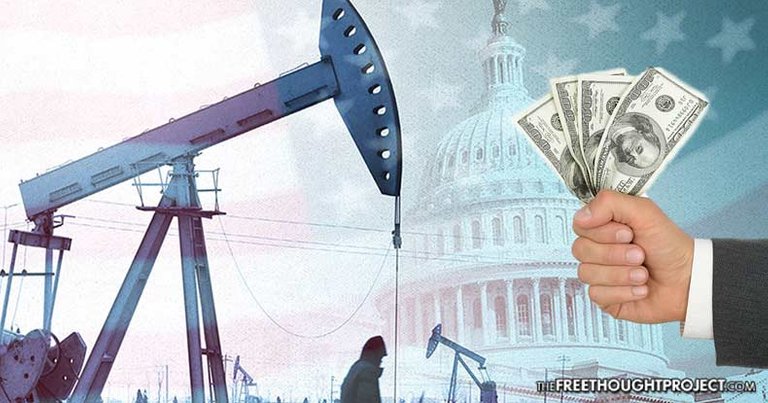
As the global energy paradigm is undergoing the next great transition from fossil fuels to renewable energy, a new report shows that fossil fuels continue to be propped up by governments with staggering amounts of subsidies.
A study published in the World Development journal, by researchers from the International Monetary Fund (IMF), found that fossil fuel subsidies amounted to $5.3 trillion dollars in 2015, rising from $4.9 trillion in 2013. This amounts to 6.5 percent of global GDP.
The authors use an expanded view of subsidies, not only “direct financial cost that result in consumers paying a price that is below the opportunity cost of the product” but also externalized, hidden costs. These hidden costs include environmental damage from air and water pollution, and damage to human health from the burning of fossil fuels, as well as “taxes applied to consumer goods in general.”
The cost of fossil fuels to human health is estimated at $74.6 billion a year; the environmental costs are more difficult to quantify but no less important, as human health depends on healthy ecosystems. The cost of U.S. military protection of overseas oil sources amounts to as much as $1 per gallon at the pump.
It is absolutely justifiable to include these hidden costs of fossil fuels as subsidies. Every economist knows that externalized costs matter, and in the case of fossil fuels these are not shouldered by the coal and oil industries profiting from their extraction. These costs are placed on consumers via the state, and they must be quantified to achieve a true picture.
According to The Guardian:
The authors also note that, unsurprisingly, coal and oil receive the most subsidies, and that China, USA and Russia are the top three subsidizers of fossil fuels.“[T]he authors discuss both consumer subsidies (when the price paid by a consumer is below a benchmark price) and producer subsidies (when producers receive direct or indirect support which increases their profitability). The authors then quantify what benefits would be achieved if the fossil fuel subsidies were reformed…
Pre-tax (the narrow view of subsidies) subsidies amount to 0.7% of global GDP in 2011 and 2013. But the more appropriate definition of subsidies is much larger (8 times larger than the pre-tax subsidies). We are talking enormous values of 5.8% of global GDP in 2011, rising to 6.5% in 2013.”
For some in the U.S. coal industry, this is not enough. West Virginia governor and long-time coal baron, Jim Justice, is in discussions with President Trump about having the federal government (taxpayers) pay a direct subsidy of $15/ton to Appalachian coal. Justice cites bogus “national security” threats for his proposal, but it’s really about using government to prop up the dying eastern U.S. coal industry. Workers in that region would be far better served diversifying into renewable energy, which provides five times more jobs than coal.
It’s important to note that coal is going down due to market forces, not a fictitious “war on coal.” The rapid fall of natural gas prices that came with the fracking boom is the primary threat to coal. In addition, wind and solar energy prices are crashing due to leaps in technology.
A third factor is flattening energy demand due to rising efficiency. No new regulations were put on coal since the 1970s -- including during the rapid 5-year decline of coal -- until Obama-era rules began going into effect in 2016.
On the subject of subsidies, it is certainly true that renewable energies have received subsidies as well, although the aforementioned study shows that they are dwarfed by fossil fuel subsidies. The externalized costs of fossil fuels in terms of damage to human and environmental health, military protection of overseas oil sources must be factored into the equation.
The fact is, renewable energy is now competitive or even cheaper than fossil fuels due to market forces – not subsidies. And this trend will continue as renewable prices keep falling due to rapid technology advances, despite the best efforts of administrations allied with the fossil fuel industry. Renewable energy is also an incredible economic machine, as solar and wind jobs are now growing 12 times faster than the U.S. economy.
To make the right choices concerning our energy paradigm, we must have accurate information, as study author Dr. David Coady notes.
“A key motivation for the paper was to increase awareness among policy makers and the public of the large subsidies that arise from pricing fossil fuels below their true social costs—this broader definition of subsidies accounts for the many negative side effects associated with the consumption of these fuels. By estimating these costs on a global scale, we hope to stimulate an informed policy debate and provide renewed impetus for policy reforms to reap the large potential benefits from more efficient pricing of fossil fuels in terms of improved public finances, improved population health and lower carbon emissions.”
It is past time to break fossil fuel’s grip on government, which appears to be the primary reason why fossil fuels are being sustained as top energy sources. If the true price of coal and oil were known to consumers – instead of being hidden through subsidies, taxes, military costs, and health and environmental costs – we would be much farther into the transition to renewable energy.
Ok, I don't mind you picking on the oil industry, as the criticism is well deserved. There is so much stuff that is subsidized. It seems that's just the way the world is working. So many special interests intersecting. It's getting dizzying to keep up with the money trail.
https://www.thebalance.com/government-subsidies-definition-farm-oil-export-etc-3305788
There's an old New Jersey street saying "Make a law make a business". I've followed Katharine Austin Fitts for several years now. She's done some great stuff.
http://www.dunwalke.com/introduction.htm
Oil should be well on its' way out the door, in favour of cleaner methods.
However, we would be without a lot of products that involve oil for their
manufacturing process.